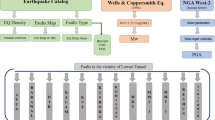Abstract
On May 12, 2008, a massive earthquake occurred along the Longmen Mountain Central Fault in Sichuan Province, China, causing serious damages to buildings near the fault. As the Longmen Mountain Central Fault and the Anterior Fault both traversed Dujiangyan and Pengzhou cities, the seismic intensity in these areas reached levels IX–XI. Therefore, these two cities were among the most seriously damaged regions. In this article, the types of damage to buildings in the two cities and their affiliated towns or villages are investigated and reported. It is found that the damage to a building is related to its structure type, distance from the faults, and so on. The results provide valuable information on the seismic resistance of buildings in similar areas.










Similar content being viewed by others
References
Academy of Building Research of Sichuan Province (2008) Technical guide for seismic design of building in countryside of Sichuan Province, Chengdu, China (in Chinese)
Ayres JM (1993) History of earthquake-resistive design for building mechanical systems. ASHRAE Trans 99(pt. 1):719–723
China Earthquake Administration (2001) Seismic ground motion parameter zonation map of China (GB 18306-2001). Issued by China quality and technology supervision administration, Beijing, China (in Chinese)
China Earthquake Administration (2008) Seismic intensity distribution map of Ms 8.0 earthquake at Wenchuan County. http://www.cea.gov.cn/manage/html/8a8587881632fa5c0116674a018300cf/_content/08_08/29/1219974148976.html. Accessed 15 Sep 2008 (in Chinese)
Li H, Zhao Y, Wang G (2007) Chuetsu earthquake damages in Niigata county of Japan. Prog Nat Sci 17(10):1255–1259
Liu H, Scott WN (2002) Seismic evaluation and retrofit strategies for the University of Alaska Anchorage Engineering Building. In: Cold Reg Eng Cold Reg Impacts on Transport and Infrastr: Proc. of 11th Internat Conf, Anchorage, AK, United states, pp 483–494
Ministry of Housing, Urban-Rural Development of the People’s Republic of China (MHURD) (2001) Code for seismic design of buildings (GB50011-2001). Press of Building Industry of China, Beijing, China (in Chinese)
Nishimura A (1997) Evolution of aseismic design notion and the lessons learned from experience of big earthquakes. Jpn Railway Eng 137:28–32
Scawthorn C (2006) Building aspects of the 2004 Niigata Ken Chuetsu, Japan, earthquake. Earthq Spectra 22(Suppl 1):S75–S88
Author information
Authors and Affiliations
Corresponding author
Rights and permissions
About this article
Cite this article
He, CR., Chen, Q., Han, SL. et al. Earthquake characteristics and building damage in high-intensity areas of Wenchuan earthquake II: Dujiangyan and Pengzhou City. Nat Hazards 57, 279–292 (2011). https://doi.org/10.1007/s11069-010-9612-8
Received:
Accepted:
Published:
Issue Date:
DOI: https://doi.org/10.1007/s11069-010-9612-8




